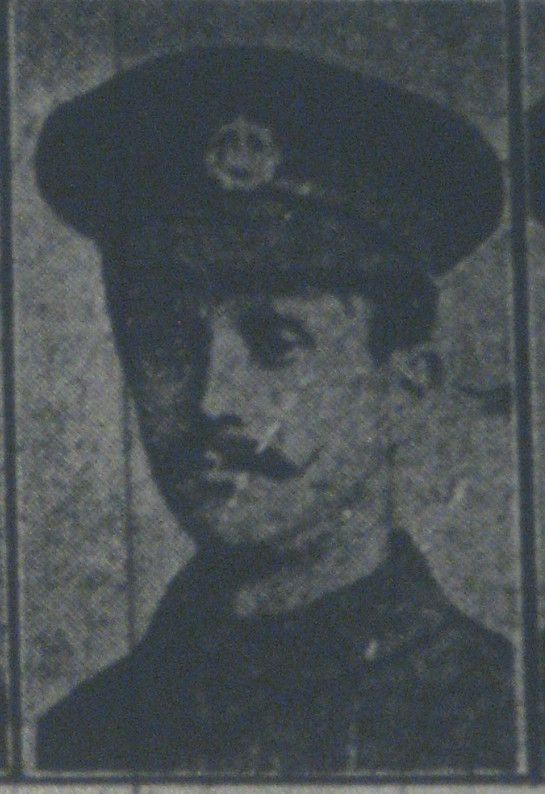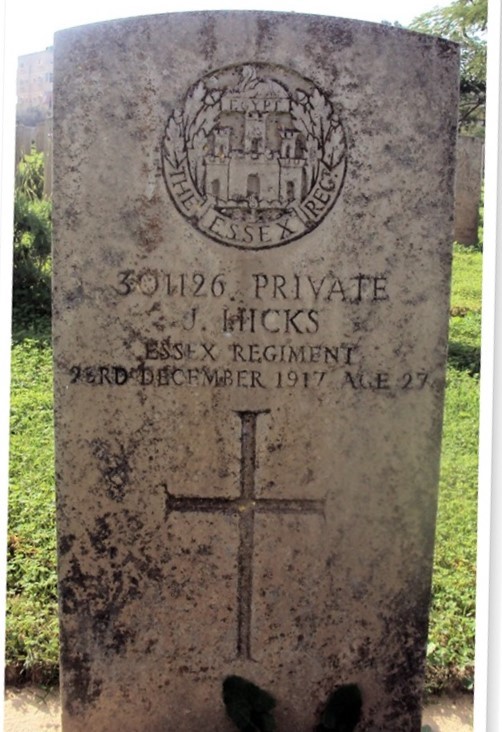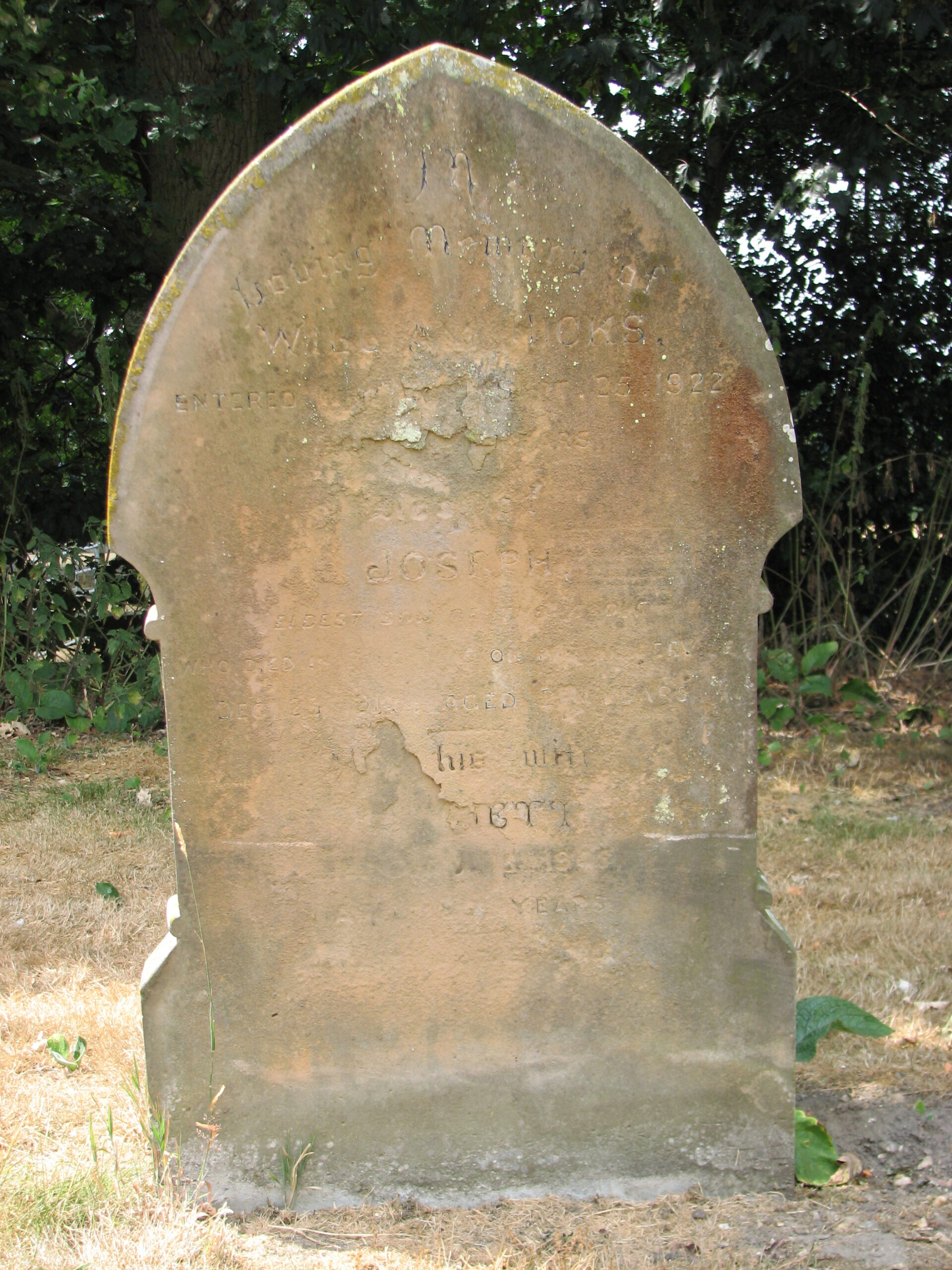Joseph Hicks (1890 - 1917)
Joseph served with the Essex Regiment, initially on the Western Front and later, in Egypt and then Palestine. He survived combat only to fall victim to an even bigger killer in that Theatre – Disease.
- 38
- Died in the Great War
- 51.977762, 1.024828
Details
| Name: | Joseph William Hicks |
| Service: | British Army |
| Unit: | 1/7th Battalion, Essex Regiment |
| Regimental Number: | 301126 (previously 12839 and 4241) |
| Rank: | Private |
| Date of Death: | 23rd December 1917 |
| Age: | 27 |
| Buried: | Plot XXII, Row E, Grave 7, Gaza War Cemetery, Gaza, Palestine |
Family Background and Early Life
Joseph Hicks was born in East Bergholt on 22nd April 1890, the second child of William and Harriet Ann Hicks.
William Hicks was an Agricultural Labourer, who had been born in East Bergholt. In 1887, he married Harriett Ann Partridge from Milden near Sudbury, and shortly afterwards they moved to William’s home village. William and Harriet would have 6 children, of whom 2 died in infancy.
The Hicks family are variously described as living “near the Hare and Hounds”, on Manningtree Road, Mill Road and also Heath Road. The evidence suggests that these descriptions all relate to the same area – the vicinity of the current High School on Heath Road.
Joseph started at the village school at Burnt Oak Corner on 11th March 1895, and remained a pupil there for just over nine years, actually leaving on his 14th birthday. After leaving school, Joseph like many men from the village found employment at the Xylonite factory at Cattawade. He stayed working there until 7th September 1914 (just one month after the outbreak of war) when he volunteered to join the Essex Regiment.
Western Front
After completing his training, Joseph was sent to France on 25th August 1915, and joined the Regiment’s 9th Battalion. The 9th Essex had arrived in France at the end of May 1915, and at the time that Joseph joined the Battalion, they were manning the trenches at Ploegsteert, to the south of Ypres. At this time, the Battalion usually rotated with another, spending 6 days in the trenches, and then 6 in reserve.
On 25th September 1915, the British launched an offensive – now known as the Battle of Loos – approximately 20 miles south of the Battalion’s positions. In an attempt to confuse the Germans as to the location of the attack, the 9th Essex and the battalions on its flanks lit bundles of wet straw soaked in paraffin that they had placed on the parapet of their trenches. At the same time, the British artillery launched a short bombardment of the German trenches.
The ruse worked, and the Germans started shelling the Battalion’s trenches. The enemy shelling was steady and accurate, and they scored several direct hits on the Battalion’s trenches. The 9th suffered 24 casualties, including 2 men killed. One of the wounded was Joseph. We do not know the exact nature of his injuries, but they were sufficiently serious for him to be evacuated to hospital in England.
Egypt
After his recovery, Joseph was posted to another of the Essex Regiment’s battalions, the 1/7th. 1 The 1/7th (pronounced “first seventh”) was originally a Territorial Force battalion – the forerunner of the Territorial Army. It had been sent to Gallipoli in August 1915, but was withdrawn from that theatre of operations in November, shortly before the Allies evacuated the Peninsula. At that time, the 1/7th were serving in Egypt as part of the Egyptian Expeditionary Force (E.E.F.).
The E.E.F. had initially been formed in 1915, to safeguard the British protectorate of Egypt (including the Suez Canal, which was vital to British trade), against the German led Ottoman (Turkish) invasion of the Sinai Peninsula.
It is not certain exactly when Joseph went out to Egypt, but there is strong evidence to suggest that it was in July 1916.
The Battalion spent much of 1916 in garrison duties around the Suez Canal. By February 1917, the British had pushed the Turks out of Sinai and the decision was made to invade Ottoman Empire territory in Palestine. As part of the preparations for this, many E.E.F. units (including the 1/7th Essex) had to cross Sinai – the Wilderness of the Bible. This trek – done in stages – took them most of February 1917 to complete.
Palestine
The EEF’s first attempt to capture Gaza – described as the southern gate of Palestine – took place on 26th March 1917, in what is now known as the First Battle of Gaza. It was a costly failure.
The First-Seventh Essex and other battalions in their Brigade – called the 161st (Essex) Brigade – were in Support to the main attack, which was carried out by another Division. 2 The 161st (Essex Brigade) – part of the 54th (East Anglian) Division – was composed of the following Territorial battalions of the Essex Regiment: 1/4th, 1/5th, 1/6th and 1/7th, as well as a Machine Gun Company, and later also a Trench Mortar Battery.
The Essex Brigade were ordered to attack a feature called Green Hill, which was captured in the face of heavy Turkish opposition. Unfortunately, during the night the other attacking Division – not realising the extent of the gains that had been made – withdrew, and the Essex Brigade’s battalions were forced to follow. The 1/7th suffered heavy losses in the fighting – 228 casualties, of whom 68 were missing.
The following month, in the Second Battle of Gaza, the British made another attempt to capture the town. In the 3 weeks since the First Battle, the Turks had heavily fortified the area, and the British were defeated with heavy losses. The 1/7th only took a very minor role in the fighting, suffering light casualties.
At the start of November – in the Third Battle of Gaza – the British launched yet another attack towards the town. This was not intended to capture Gaza, merely to hold Turkish forces there, in order to try to assist British attacks elsewhere.
In the course of the fighting, the 1 / 7th Essex initially took their objective, but could not hold it. They made another attempt the following day but were beaten back by Turkish machine gun fire. Over the 3 days of the Battle of Gaza, the Battalion again suffered heavy losses, totalling 281 casualties.
Capture of Jerusalem
As a result of the British attacks, Gaza fell shortly after the Third Battle. This, combined with the recent loss of Beersheba on 31st October, forced the Turkish forces to retreat. Over the next few weeks, the British offensive continued, and culminated in the capture of Jerusalem on 9th December 1917. The 1/7th did not play a major role in the pursuit of the Ottoman forces, in part due to their heavy losses at the Third Battle of Gaza.
Due to the hot, insanitary conditions, there was a far larger proportion of casualties due to illness and disease in Palestine, than on the Western Front. In fact, during the Sinai and Palestine Campaign, the British and the Dominions suffered nearly 10 times more casualties from non-battle causes – primarily disease – than those that resulted from the fighting. footnote] In the Sinai and Palestine Campaign, the British and the Dominions suffered a total of 51,451 battle casualties: 12,873 killed/missing, 37,193 wounded, and 1,385 captured. An additional 503,377 were hospitalized as non-battle casualties, mostly from disease; 5,981 of these died, and most of the rest were returned to duty. (Taken from “Medical Services: Casualties and Medical Statistics of the Great War.” By Major T.J. Mitchell and Miss G.M. Smith, His Majesty’s Stationary Office, 1931).[/footnote]
One of the most significant diseases in that theatre of operations was Malaria. Borne by Mosquitos, if not treated quickly Malaria can overwhelm the patient’s immune system, rapidly resulting in death.
Joseph died of Malaria on 23rd December 1917, at Deir Sineid a small village approximately 6 miles north-west of Gaza, which was also the location of Number 35 Casualty Clearing Station.
Joseph was laid to rest in what is now called the Gaza War Cemetery.
Postscript
Joseph is remembered on his parents’ gravestone in East Bergholt Cemetery, though sadly the inscription has worn away over the years and is now almost illegible. It read: “AlSO OF JOSEPH, ELDEST SON OF THE ABOVE, WHO DIED IN PALESTINE ON ACTIVE SERVICE, DEC 23 1917 AGED 28 YEARS”
Despite the conflicts that have torn the region apart since 1948 and which have sometimes resulted in damage to the Gaza War Cemetery, it has always been maintained to an extremely high standard by local men employed by the Commonwealth War Graves Commission (CWGC). Their care extends far beyond the duties of employment. Prominent among these men are 3 generations of the Jaradah family who – over the last 75 years – have lovingly tended the Commonwealth War graves in Gaza.
January 2024 Update – At this time, there seems to be no definite news as to what damage has recently been inflicted on the Gaza War Cemetery, nor of the welfare of the local CWGC employees who tended it prior to the outbreak of hostilities in October 2023.
Copyright © Mark Ashmore, 2024
- 38
- Died in the Great War
- 51.977762, 1.024828



